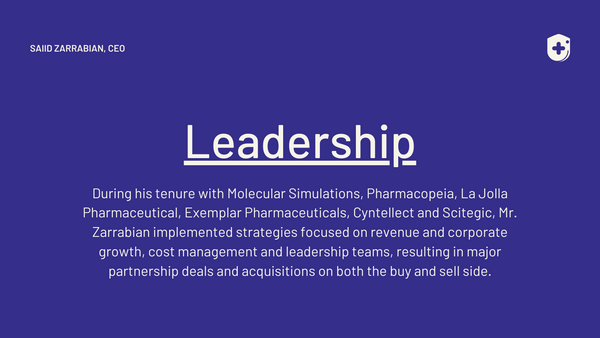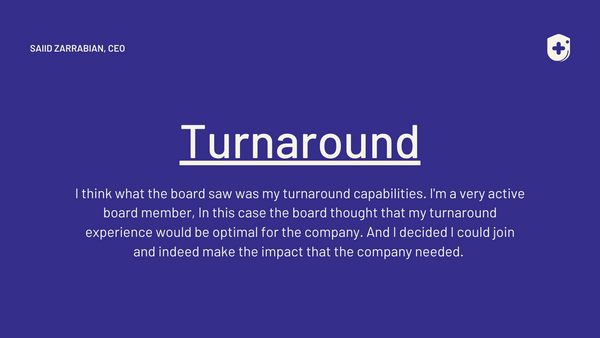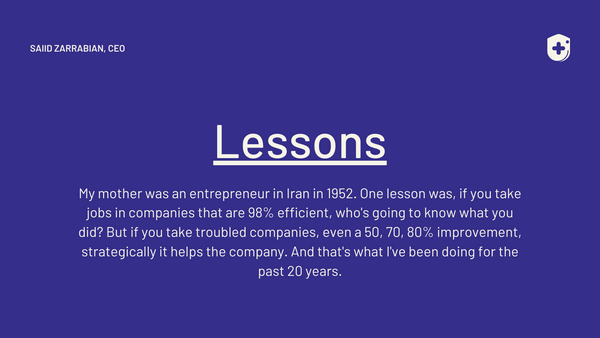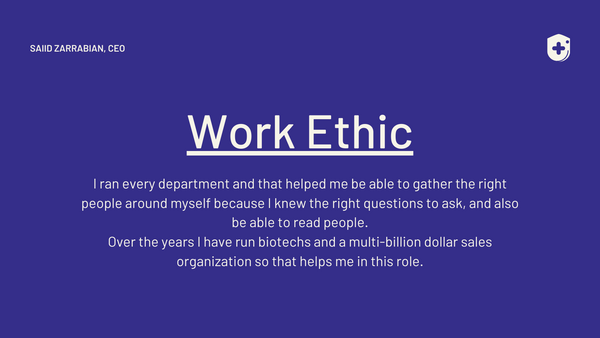Kintara Therapeutics is a biotech company formed in August 2020 through the acquisition of Adgero Biopharmaceuticals by Delmar Pharmaceuticals. Kintara is headed up by Saiid Zarrabian, a proven CEO with nearly 30 years’ experience as a senior executive, advisor and board member, with the past 25 years primarily focused on turnaround strategies in the life sciences industry. Kintara Therapeutics is currently addressing two rare cancers for underserved medical needs. Mr. Zarrabian’s tenure at Kintara started in the role as an independent board member in 2017 before taking over as the CEO in 2018. One of the strongest motivators for his return to active leadership was VAL-083, the company’s drug candidate for patients suffering from GBM - the deadliest form of brain cancer where existing therapies provide very little benefit.
What made Kintara so appealing?
Saiid Zarrabian:
I had been involved in multiple biotechs that had worked on different kinds of drugs for a couple of decades, with the last one being La Jolla, where I helped restructure the company and ultimately led to getting a new drug approved a few years after my departure. Kintara was different because somehow GBM tugged at me differently. It was sparked by personally speaking to patients and their families and from a very personal perspective seeing the devastating impact of this disease. As with many of us, I've had untreatable cancer in my immediate family, so I know first-hand how difficult and devastating untreatable cancers can be. And Kintara gave me the opportunity and the chance to try my best to do something about it.
The Facts about GBM.
Saiid Zarrabian:
When I found out about the disease and the fact that it's been 20 years since a new life extending drug was approved for first-line GBM, with patients' median survival at less than 18 months, something drew me in. I think this was probably the one thing that tugged on a different side of the psyche. It wasn't the business side, it was the emotional and human side. And it seems like I could actually do something about it. There is tremendous gratification that can be gained from trying to, and hopefully succeeding in, getting a new treatment approved and giving these patients hope.
What's your management philosophy?
Saiid Zarrabian:
You will likely not read anything completely novel here. These are well recognized tools of management, but too often we ignore them because we have the hurry sickness: This is where management is too hurried and thus doesn’t have time to do it right the first time, but sadly we find, has the time to do it again!
To help mitigate the above factor, one of the basic philosophies which I personally subscribe to is to bring up issues as soon as possible because then we can together do something about it. We can update expectations, if possible, adjust and recover, bring additional resources, and do more. But if we discover, or worse, share the issues too late, we have squandered an opportunity to fix an issue. The message is don't be afraid of bad news. I really try and enforce this because it's that bad news, and what you do about it which in my view often distinguishes success from failure. There's always going to be bad news. It doesn't matter what business you're in, maybe more profoundly in biotech where a late-stage failure can be binary, or at least provide a delay and additional expenses, which can be sizeable, and too often irrecoverable in biotech.
What are the latest breakthroughs at Kintara?
Saiid Zarrabian:
We have initiated participation in a registration study for our lead indication in GBM. That was a major accomplishment on many levels. This program is being executed by a non-profit organization founded in 2017 by 130 clinicians and other experts called Global Coalition for Adaptive Research. In my opinion, this currently enrolling platform trial called GBM AGILE is the world's best GBM trial design and execution plan. We are very proud and excited to have joined this group of world-renowned GBM and clinical trial experts who've been developing and advancing the GBM AGILE program for the past four years. Their goal is heroic: To reduce drug development costs and timelines for rare and deadly diseases. This was in response to the continuing increase in cost and timelines for drug development, as exemplified with their first endeavor in GBM, where the approved therapy for first-line is over 20-years old, and has been generic since 2010. And has very limited benefit based on incredibly short, and low, patient survival rates.
This dedicated group of people are utilizing a novel, but extremely powerful clinical trial tool called adaptive trial design to accelerate drug development. Luckily for us, some of their principals were GBM-centric so the first indication they decided to pursue was GBM. From 2017 to now with financial support from the National Brain Tumor Society, the National Foundation for Cancer Research, and the Asian Fund for Cancer Research, they advanced the program by submitting an adaptive platform trial design plan to the FDA and getting the highest level of support and approval for it. Then, they initiated the effort to sign on all the clinical sites that would enroll for this study, with over 35 US sites currently enrolling GBM patients in this registrational study and continuing to expand.
Recently, Kintara announced that we had the unique situation to evaluate VAL-083 in all three patient subtypes in this trial, including the recurrent setting, as well as newly-diagnosed methylated and newly-diagnosed unmethylated patients. If we were to undertake these three patient studies at Kintara, we would have to run three separate trials with costs estimated to double or triple versus participating in the GBM AGILE trial, and we would have to do so serially over a decade or so. The power of GBM AGILE’s approved adaptive design registration trial gives Kintara three shots on goal, in a much shorter time frame by recruiting all three patient subtypes in parallel, and for a fraction of the costs of three separate studies.
The above efforts have taken GCAR four years to implement, and we get the benefit of their four years of efforts, planning, and approvals in a very short period of time. As two major examples, GCAR has been executing and enrolling patients for the GBM AGILE study since June 2019, and has already added over 35 US sites that are already enrolling for the GBM AGILE program. Although Kintara joined this trial on Jan 6, 2021, a little over three months ago, we are expecting to be enrolling in the majority of these sites during Q2, 2021, thus accelerating a two-year effort into an estimated six months. So, we get the benefit of all that.
The personal side of this, in addition to obviously trying to accelerate a new treatment for the patients, is, if we, as one of the small companies in this trial, can show that the adaptive platform design can be an accelerative tool, we might fundamentally improve the way drug development and discovery is done. We will have shown that with this platform small biotechs can compete with the bigger multi-billion-dollar companies in clinical trial efforts, thus creating better and more opportunities for smaller biotechs, and ultimately for patients by reducing the high cost of drug development, especially important given the high portion of costs associated with clinical trials. And it is very encouraging that Kintara is currently the only company in late-stage clinical trials for these three distinct GBM patient subtypes. As I mentioned earlier, this gives Kintara three shots on goal as we could succeed in any of those GBM patient groups. And if we get some favorable tailwinds, we could succeed in all three, which would be a major achievement on behalf of all our stakeholders: Patients, treating physicians who face a daunting task in informing the patients of the poor current outlook, the employees and consultants, many of whom have been working towards this goal for approaching a decade, and our shareholders who have placed their faith in us by investing in our endeavors.
I would be remiss in not mentioning that Kintara has been an incredibly effective user of shareholder capital: To date we have spent only about $50M in total, and are as described above, already enrolling in an FDA approved registration study in partnership with many of the world’s leading GBM and clinical trial experts, and with a second recently acquired photodynamic therapy for Cutaneous Metastatic Breast Cancer (CMBC). I’m pleased that our Kintara structure and team has put us in a position to have been invited to partner with GCAR.
What is the Mechanism of action for each drug?
Saiid Zarrabian:
They're obviously different. They are for two different indications, two completely different drugs. So, I'll go individually through each one. On VAL-083, it's what's called a bifunctional DNA targeting agent, and that means it goes to the DNA strand. And whereas the current approved drug temozolomide breaks a single strand of the DNA, our drug actually breaks the cross strand. And this MGMT enzyme I mentioned allows the cancer cell to repair that single strand damage caused by temozolomide but it cannot repair the damage that VAL-083 does. REM-001, which is a second asset, is completely different. You are given an injection of REM-001 which is a light activated drug. Twenty-four hours after the injection the patient comes back to the clinic and we activate the drug in the tumor with a simple red light that is able to penetrate the tumor tissue. During this light activation period the drug releases oxygen free-radicals that induce tumor cell death by a mechanism called apoptosis.
So, in the VAL-083 case, we're breaking the DNA strand and breaking the cross strand and keeping the cell from replicating. In the REM-001 case, we're activating a drug that induces local tumor destruction analogous to X-rays. However, the benefit with our REM-001 mechanism of action is that it does not cause permanent normal tissue damage like radiation does. As a reference point, we have a very informative video in the presentation section of our website on CMBC that explains the indication and how REM-001 works.
Tell us about the team you've built at Kintara?
Saiid Zarrabian:
We recruited Dr. John de Groot who at the time was interim chairman of neuro-oncology at MD Anderson Cancer Center. We recruited Dr. David Reardon, who is a chairman of a department of neuro-oncology at Dana Farber and Tim Cloughesy at the UCLA David Geffen School of Medicine who is also a world renown neuro-oncology physician. It's amazing how one thing leads to another if you take the right steps. So, we recruited five highly qualified scientific advisory board members to really escalate the scientific and clinical trial planning going forward. The people I just mentioned were key contributors to our joining the GBM AGILE registration trial, and are of tremendous value given their expertise gathered via their participating in a large number of clinical trials. As far as our long-term strategic plan post the hoped-for success of VAL-083 in GBM, we plan to partner with an oncology company with a strong sales franchise to distribute the drug post approval.
Kintara Milestones
Kintara Therapeutics is currently addressing two rare cancers for underserved and unmet needs. Mr. Zarrabian’s tenure at Kintara started in the role as an independent board member in 2017 before taking over as the CEO in 2018. One of the strongest motivators for his return to active leadership was the company’s drug candidate for patients suffering from GBM, the deadliest form of brain cancer where existing therapies provide very little benefit. These patients have been relying on temozolomide, which was approved for first-line therapy over 20 years ago with limited benefit. Mr. Zarrabian and the management at Kintara strongly believe that VAL-083 holds the potential for increasing the life expectancy of all GBM patients. Under the guidance of Mr. Zarrabian, the company is nearing completion of two Phase 2 trials and initiated a registration study in January of 2021. In addition, Mr. Zarrabian expanded the company’s portfolio in August 2020 with the acquisition, and pivotal financing, of Adgero Biopharmaceuticals and its asset REM-001, a second-generation photodynamic therapy, which is planned to initiate a lead-in study during 2021 in preparation for a Phase 3 pivotal study.
Next steps for Kintara
Under Mr. Zarrabian's guidance, Kintara has secured a role in a critical FDA endorsed GBM study, through the Global Coalition for Adaptive Research’s (GCAR) GBM AGILE program. This innovative study is expected to provide an accelerated and less costly development path through a seamless phase 2/3 international registration study design. This program has been enrolling patients since June 2019, and initiated the Kintara arm for all three patients subtypes as of January 6, 2021. GBM AGILE currently has more than 35 recruiting sites with plans to grow to 40 sites in the very near future, as well as adding potential sites in Europe, Canada and China. A major advantage of Kintara’s participation in the GBM AGILE adaptive platform trial with other companies is the cost of the control arm participation will be shared by all participating companies, which reduces capital requirements to the benefit of shareholders. Of the three companies participating, Kintara’s VAL-083 is the only molecule that has currently been cleared to enroll all three GBM patient subtypes.
Additionally, with its REM-001 platform, Kintara intends to initiate a 15-patient lead-in study in 2021 as the first step in a planned Phase 3 study in Cutaneous Metastatic Breast Cancer (CMBC). This debilitating disease affects an estimated 40,000 US breast cancer patients per year. Current CMBC treatment options are limited and have little to no effect.
Located in San Diego, California, Kintara is dedicated to the development of novel cancer therapies for patients with unmet medical needs. Kintara is developing two late-stage, Phase 3-ready therapeutics for clear unmet medical needs with reduced risk development programs. The two programs are VAL-083 for GBM and REM-001 for CMBC. VAL-083 is a "first-in-class", small-molecule chemotherapeutic with a novel mechanism of action that has demonstrated clinical activity against a range of cancers, including central nervous system, ovarian and other solid tumors (e.g., NSCLC, bladder cancer, head and neck) in U.S. clinical trials sponsored by the National Cancer Institute (NCI). Based on Kintara's internal research programs and these prior NCI-sponsored clinical studies, Kintara is currently conducting clinical trials to support the development and commercialization of VAL-083 in GBM. Kintara is also advancing its proprietary, late-stage photodynamic therapy platform that holds promise as a localized cutaneous, or visceral, tumor treatment as well as in other potential indications. REM-001 therapy, has been previously studied in four Phase 2/3 clinical trials in patients with CMBC, who had previously received chemotherapy and/or failed radiation therapy. With clinical efficacy to date of 80% complete responses of CMBC evaluable lesions, and with an existing robust safety database of approximately 1,100 patients across multiple indications, Kintara is advancing the REM-001 CMBC program to late-stage pivotal testing. SAFE
HARBOR STATEMENT
Any statements contained in this press release that do not describe historical facts may constitute forward-looking statements as that term is defined in the Private Securities Litigation Reform Act of 1995, including statements regarding the status of the Company's clinical trials and the GBM AGILE study. Any forward-looking statements contained herein are based on current expectations but are subject to a number of risks and uncertainties. The factors that could cause actual future results to differ materially from current expectations include, but are not limited to, risks and uncertainties relating to the impact of the COVID-19 pandemic on the Company's operations and clinical trials; the Company's ability to develop, market and sell products based on its technology; the expected benefits and efficacy of the Company's products and technology; the availability of substantial additional funding for the Company to continue its operations and to conduct research and development, clinical studies and future product commercialization; and, the Company's business, research, product development, regulatory approval, marketing and distribution plans and strategies. These and other factors are identified and described in more detail in the Company's filings with the SEC, including the Company's Annual Report on Form 10-K for the year ended June 30, 2021, the Company's Quarterly Reports on Form 10-Q, and the Company's Current Reports on Form 8-K.
For more information, please visit www.kintara.com or follow us on Twitter at @Kintara_Thera, Facebook and Linkedin.









